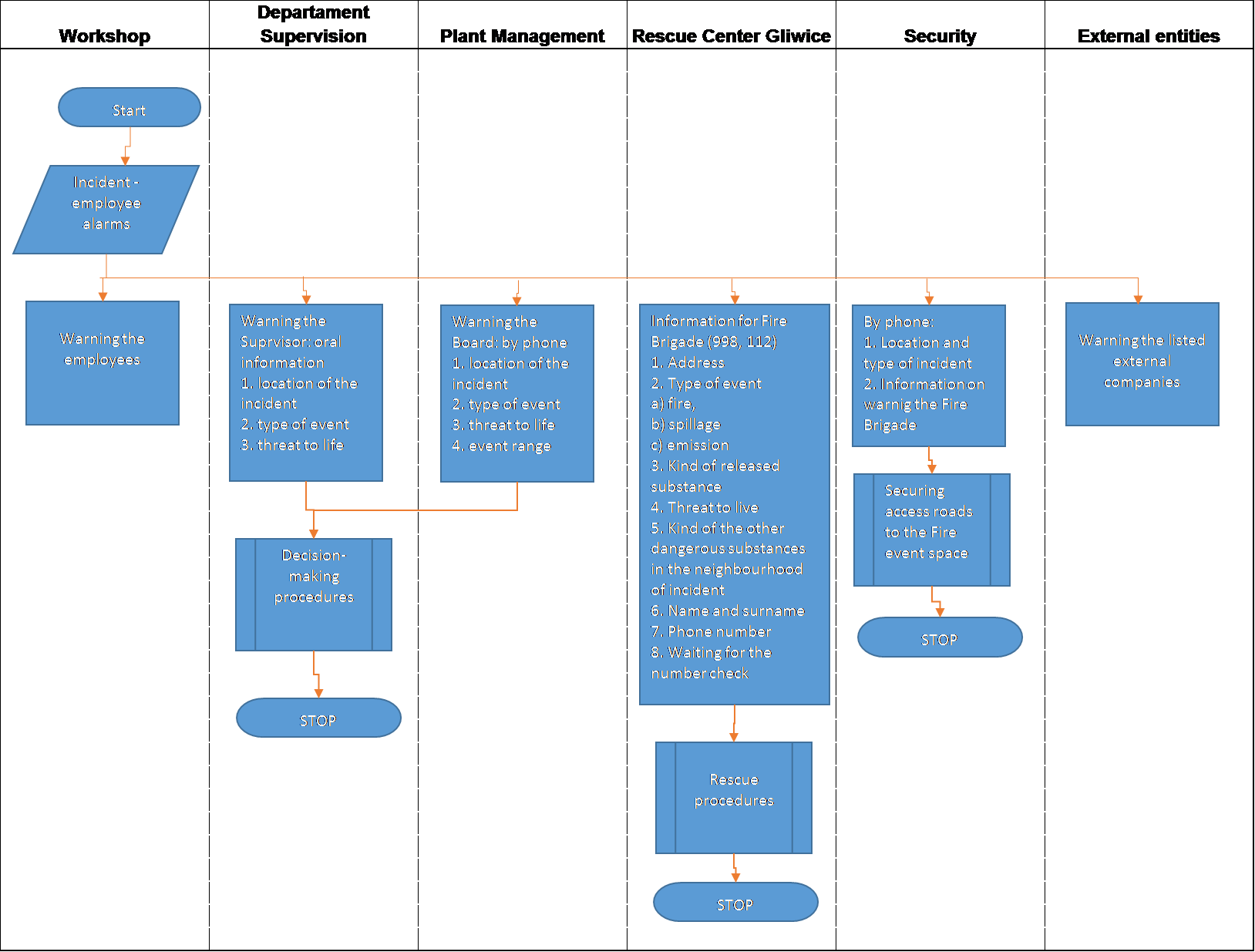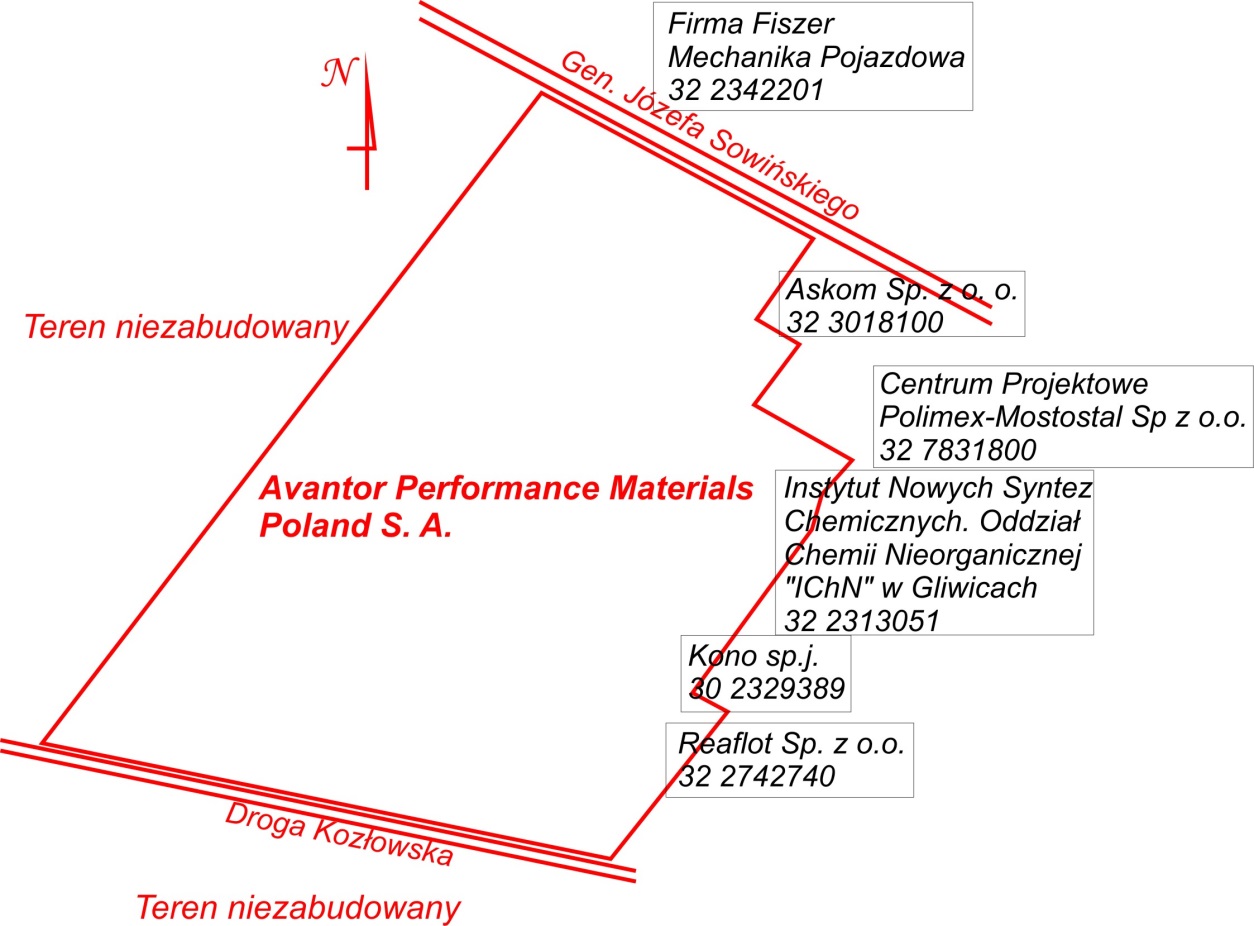
PRODUCTS:
> analytical
> industrial raw materials
> products for defence
and safety
TRADES:
> pharmacy
> food and feed industry
> chemical
and petrochemical
> environment protection
> defence and safety
> research and
development entities
|
| main / products and trades / environment protection |
According to Art. 261a of the Environmental Protection Act (Journal of Laws of 2016, item 672), I inform that Avantor Performance
Materials Poland S.A. is an increased risk of serious industrial accidents according to the Seveso III Directive.
Basic information about the threat and ways of preventing them.
1. Information about the plant
| 1 |
Applicant |
Avantor Performance Materials Poland Spółka Akcyjna |
| 2 |
Headquarters |
44-101 Gliwice, ul. Sowińskiego 11 |
| 3 |
Other contact detail |
Tel.: 032 2392000
Fax: 032 2392370
E-mail: [email protected]
WWW: www.poch.com.pl |
| 4 |
Head of the Plant |
Jakub Ślusarz |
| 5 |
Contact person |
Krzysztof Skirmuntt
Environment protection manager
Tel.: 0606643767, 032 2392466;
Fax: 032 2392202
E-mail: [email protected] |
2. Scope of the activity
| 1 |
KRS |
0000010108, Sąd Rejonowy w Gliwicach |
| 2 |
Regon |
271563380 |
| 3 |
The nature of business |
PKD 2007: 2013Z Production of other basic inorganic chemicals
PKD 2004: 2413Z Production of other basic inorganic chemicals
podstawowych pozostałych |
| 4 |
Description of the process |
The company is engaged in the production of chemicals and chemical reagents for industry,
research laboratories and various industrial specialties for the Polish and foreign market.
In chemical production in plant we use chemical reactions in water solutions and partially in
organic solvents. Volume of reactions is between few liters to 3 cubic meters. In production we
use a set of reactors and vessels arranged according to needs.
Used equipment:
- Universal chemical reactors (e.g. Lampart) heated by saturated steam, by electricity or natural gas equiped equipped with mixers and/or covers;
- Filter presses – filtration systems working with pumps;
- Vessels for densification or crystallization;
- centrifuges
- distillers and separation columns;
- dryers
- absorbers, adsorbers, scrubers and other devices for reducing the emission.
|
3. Classification of the plant
| General classification |
According to the Regulation of the Minister of Development of 29 January 2016 (Journal of Laws of 2016, item 138),
which constitutes the implementation of the Polish annexes to the Seveso III Directive, the plant is classified as an increased risk
of major industrial accidents. |
| Detailed classicfication |
Section |
Subsection |
Classification |
| ‘H’ - HEALTH HAZARDS
| H1 ACUTE TOXIC Category 1, all exposure routes |
lower-tier establishment |
| H2 ACUTE TOXIC
Category 2, all exposure routes
Category 3, inhalation exposure route
|
lower-tier establishment |
| ‘P’ - PHYSICAL HAZARDS |
P5a FLAMMABLE LIQUIDS
P5b FLAMMABLE LIQUIDS
P5c FLAMMABLE LIQUIDS
P8 OXIDISING LIQUIDS AND SOLIDS
|
lower-tier establishment |
| ‘E’ - ENVIRONMENTAL HAZARDS
| E1 Hazardous to the Aquatic Environment in Category Acute 1 or Chronic 1 |
lower-tier establishment |
| E2 Hazardous to the Aquatic Environment in Category Chronic 2 |
lower-tier establishment |
Table 1: Chemicals identified by name in Polish regulation and in the Directive
| Name |
CAS |
Classification |
|
Ammonium nitrate (as technical grade – fertilizers not in production) |
6484-52-2 |
Below lower-tier establishment |
| Arsenic trioxide |
1327-53-3 |
| Methanol |
67-56-1 |
| Dimethyl sulfate |
77-78-1 |
Petroleum products
Petroleum products and alternative fuels
a) gasolines and naphthas,
b) kerosenes (including jet fuels),
c) gas oils (including diesel fuels, home heating oils and gas oil blending streams)
d) heavy fuel oils
e) alternative fuels serving the same purposes and with similar properties as regards flammability and environmental
hazards as the products referred to in points (a) to (d)
|
|
|
Mixtures* of sodium hypochlorite classified as Aquatic Acute Category 1 [H400] containing less than 5 % active chlorine and not
classified under any of the other hazard categories in Part 1 of Annex I. I.
* Mixtures shall be treated in the same way as pure substances provided they remain within concentration limits set according
to their properties under Regulation (EC) No 1272/2008, or its latest adaptation to technical progress, unless a percentage composition
or other description is specifically given.
|
|
Table 2: Chemicals classified according to hazard symbols in accordance with Polish regulation and the Directive
| Group of substances |
Classification based on calculations |
|
Section ‘H’ - HEALTH HAZARDS |
|
H1 ACUTE TOXIC Category 1, all exposure routes |
Below upper-tier establishment |
H2 ACUTE TOXIC
- Category 2, all exposure routes
- Category 3, inhalation exposure route
|
|
Section ‘P’ - PHYSICAL HAZARDS |
5a FLAMMABLE LIQUIDS
- Flammable liquids, Category 1, or
- Flammable liquids Category 2 or 3 maintained at a temperature above their boiling point, or
- Other liquids with a flash point = 60 °C, maintained at a temperature above their boiling point
|
Poniżej wartości krytycznej dla zakładów o dużym ryzyku wystąpienia poważnej awarii |
P5b FLAMMABLE LIQUIDS
- Flammable liquids Category 2 or 3 where particular processing conditions, such as high pressure or high temperature, may
create major-accident hazards, or
- Other liquids with a flash point = 60 ?C where particular processing conditions, such as high pressure or high temperature,
may create major-accident hazards
|
P5c FLAMMABLE LIQUIDS
Flammable liquids, Categories 2 or 3 not covered by P5a and P5b
|
P8 OXIDISING LIQUIDS AND SOLIDS
- Oxidising Liquids, Category 1, 2 or 3, or
- Oxidising Solids, Category 1, 2 or 3
|
|
Section ‘E’ - ENVIRONMENTAL HAZARDS |
|
E1 Hazardous to the Aquatic Environment in Category Acute 1 or Chronic 1
|
Below upper-tier establishment |
|
E2 Hazardous to the Aquatic Environment in Category Chronic 2
|
5. Internal and external alarms
Establishment maintains:
- List of function workers notified in the emergency situation for business phones,
- List of notified external services,
- List of contact phones for companies adjacent to the plant.
The notification system is included in the Chemical Rescue Plan and in the Plant Protection Plan
Hazardous procedures are described in the Chemical Rescue Plan.

List of external entities notified in the event of a threat:

6. Important numbers:
998 or 112 – Fire Brigade or Rescue Center
32 2017616 Regional Inspectorate for Environmental Protection
32 2319876 or 0 501140480 Rescue Center Gliwice
7. Basic rules
- Prohibition of proximity to the danger area
- Avoid contact with released salts or products of its decomposition, reaction, etc..
- Absolute subordination to the command of the rescue / rescue action
- Evacuation procedure (general):
a) Secure your workplace
b) Go to the designated collection point
c) Inform others who may have not received information about the event.
8. Warning of the Society
The public can be alerted with:
– public address systems for emergency services
– Civil Defense Alarm Sirens,
– information in local radio and television stations.
|
|
|
